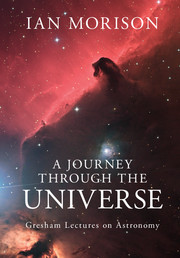Book contents
- Frontmatter
- Dedication
- Contents
- Preface
- Acknowledgements
- 1 Watchers of the skies
- 2 Our Sun
- 3 Aspects of our Solar System
- 4 The rocky planets
- 5 The hunt for Planet X
- 6 Voyages to the outer planets
- 7 Harbingers of doom
- 8 Impact!
- 9 Four hundred years of the telescope
- 10 The family of stars
- 11 Aging stars
- 12 The search for other worlds
- 13 Are we alone? The search for life beyond the Earth
- 14 Our island Universe
- 15 Wonders of the southern sky
- 16 Proving Einstein right
- 17 Black holes: no need to be afraid
- 18 It’s about time
- 19 Hubble’s heritage: the astronomer and the telescope that honours his name
- 20 The violent Universe
- 21 The invisible Universe: dark matter and dark energy
- 22 The afterglow of creation
- 23 To infinity and beyond: a view of the cosmos
- Index
- Plate section
- References
9 - Four hundred years of the telescope
Published online by Cambridge University Press: 05 October 2014
- Frontmatter
- Dedication
- Contents
- Preface
- Acknowledgements
- 1 Watchers of the skies
- 2 Our Sun
- 3 Aspects of our Solar System
- 4 The rocky planets
- 5 The hunt for Planet X
- 6 Voyages to the outer planets
- 7 Harbingers of doom
- 8 Impact!
- 9 Four hundred years of the telescope
- 10 The family of stars
- 11 Aging stars
- 12 The search for other worlds
- 13 Are we alone? The search for life beyond the Earth
- 14 Our island Universe
- 15 Wonders of the southern sky
- 16 Proving Einstein right
- 17 Black holes: no need to be afraid
- 18 It’s about time
- 19 Hubble’s heritage: the astronomer and the telescope that honours his name
- 20 The violent Universe
- 21 The invisible Universe: dark matter and dark energy
- 22 The afterglow of creation
- 23 To infinity and beyond: a view of the cosmos
- Index
- Plate section
- References
Summary
In October 1608, a Flemish spectacle-maker by the name of Hans Lippershey applied for a patent for his spyglass which allowed distant objects to be seen as distinctly as if they were nearby. Knowledge of it quickly spread around Europe and soon such telescopes could be bought quite easily. In England, the mathematician Thomas Harriot used one to make what are believed to be the first telescopic observations of the Moon. The first known (rather crude) drawing shown in Figure 9.1 was dated 26 July 1609, followed later with an impressive map of the Moon. Harriot did not publicise his observations and, as a result, it is widely thought that the first astronomical drawings made using a telescope were made by Galileo Galilei.
The spyglass came to the attention of Galileo in July 1609; he quickly worked out the principle of the telescope and built himself an eight-power telescope. Grinding his own lenses and optimising the shape of the objective lens, he gradually improved the power and image quality of the telescope and began to observe the heavens, making his first astronomical observations in the autumn of 1609. In March 1610, he published The Starry Messenger, which described his observations of the Moon and planets – particularly those of Jupiter and its moons:
On the seventh day of January in this present year 1610, at the first hour of night, when I was viewing the heavenly bodies with a telescope, Jupiter presented itself to me; and because I had prepared a very excellent instrument for myself, I perceived (as I had not before, on account of the weakness of my previous instrument) that beside the planet there were three starlets, small indeed, but very bright.
- Type
- Chapter
- Information
- A Journey through the UniverseGresham Lectures on Astronomy, pp. 118 - 132Publisher: Cambridge University PressPrint publication year: 2014



